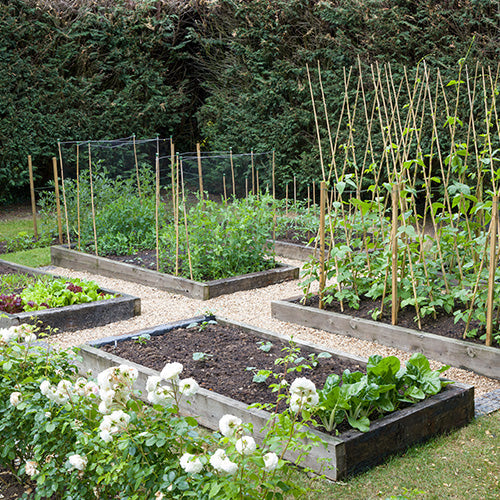When to Plant Raspberry Canes
Raspberry canes are best planted between November and March when they’re dormant. However, do not plant them when the soil is frozen or waterlogged, as this will prevent their roots from establishing properly and affect successful growth.
How to Plant Raspberry Canes
Choose a sheltered, sunny area of the garden away from cold, drying winds. Although raspberries tolerate part shade, they fruit best in sun.
Plant your canes in rows 1.8m (6ft) apart, each running north to south to catch maximum sunlight. Floricaine varieties will need support from a system of posts and wires about 1.8m (6ft) in height, though most primocane varieties will grow fine without.
For floricane varieties, strain wires horizontally between the posts at 60cm (2ft) intervals, starting with the first wire at about 45cm (18in) from the ground and rising to the last wire at about 1.7m (5½ft) high. Then, dig out a trench where the rows are to be, following the ground preparation advice above.
Plant bare-root canes with the roots well spread out in each planting hole, setting the plants out 40cm (16in) apart. The uppermost roots should be no more than 5cm (2in) below the soil, since deeper planting will discourage plants from producing new canes this season. Set potted canes so that the tops of the rootballs will be about 2.5cm (1in) below the soil surface. After planting, tread the soil around the roots to firm the canes in.
Finish by cutting the stem growth back to approximately 25cm (10in) above soil level. Plants establish much better if they are not allowed to fruit in their first season. Since raspberries are often attacked by birds, particularly when grown on allotments, take this opportunity to provide supports for bird-proof garden netting. A permanent fruit cage, though initially expensive, is the easiest to manage.
Planting Raspberries in Containers
Some raspberry varieties are capable of growing within containers, making for an ideal option if limited on space. However, they will likely need to be planted in the ground after their third year.
Choose a container around 38cm (15in) in width and fill with multi-purpose garden compost. Plant your raspberry cane in the centre, at about the same height it was previously planted and tie the stems to a post, such as a bamboo cane, for support. From there, all other advice found in this guide will apply.

 How to Grow Raspberries
How to Grow Raspberries

 Ground Prep
Ground Prep

 Planting
Planting

 Plant Care
Plant Care

 Harvesting
Harvesting

 Problems
Problems

How to Grow
Ground Preparation
Planting
Plant Care
Harvesting
Problems










Leave a comment
All comments are moderated before being published.
This site is protected by hCaptcha and the hCaptcha Privacy Policy and Terms of Service apply.